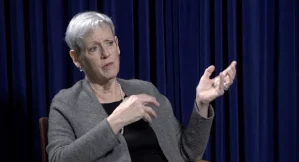News
Ohio’s former chief justice says redistricting was ‘doomed to fail’ and Ohio needs a new way to draw maps
By: Karen Kasler | Statehouse News Bureau
Posted on:
COLUMBUS, Ohio (Statehouse News Bureau) — The Republican former chief justice of the Ohio Supreme Court has done as she said she would earlier this year: She’s working with a group that wants to change the way Ohio’s conducts redistricting. She and the court’s three Democrats ruled against them every time they came before the court last year.

“In retrospect, looking at those constitutional amendments, realizing who populated the commission, it was doomed to fail,” said former Ohio Supreme Court Chief Justice Maureen O’Connor.
She was the critical fourth vote in ruling Republican-drawn maps unconstitutionally gerrymandered last year. She and the court’s three Democrats struck down the state legislative maps drawn by the GOP-dominated Ohio Redistricting Commission five times, and twice ruled against the congressional maps approved by the commission. The gerrymandered state maps were put into place anyway when a group of voters including a Republican former state representative and Ohio Right to Life president Mike Gonidakis filed suit in federal court. The congressional map was also used last year but the U.S. Supreme Court has ordered the Ohio Supreme Court review its ruling that it’s unconstitutional.
O’Connor couldn’t run for re-election because of a law that caps a judge’s age at 70. She said earlier this year she believes citizens should draw the next maps. She’s helped draft an amendment to create the Ohio Citizens Redistricting Commission.
In 2005, voters resoundingly rejected an amendment to create a commission to draw district lines. O’Connor said the protracted redistricting saga that started two years ago along with the rejection of the Issue 1, the Republican-backed amendment to require 60% voter approval to pass future amendments including one on abortion access this fall, has convinced her that voters are ready for this idea now. .
“We’ve got proof just recently in the election that citizens in Ohio are involved,” O’Connor said. “They care about their government, they care about their state and they care about the constitution and the powers in that constitution that are reserved for the people, and the fact that they can make things happen when they vote.”
The group proposing the amendment also includes O’Connor’s Democratic former colleague Yvette McGee Brown, who had been appointed to serve out O’Connor’s remaining justice term when she was elected chief justice in 2010. McGee Brown left the court after two years.
O’Connor said she knows the criticisms. For instance, that only lawmakers can draw the maps, which she said this constitutional amendment would change. She says she’s also heard the concern that the commission will be dominated by partisans.
The 15-member commission would be made up of 5 Republicans, 5 Democrats and 5 independents selected at random from a pool of 45 candidates screened by four bipartisan retired judges who are themselves selected by bipartisan members of the state ballot board. Current and former politicians, party officials and lobbyists would be banned from serving on it. O’Connor said it’s easy to see where things broke down with the current commission.
“Whether you’re a D or an R, you have that situation where you’ve got a supermajority and you want to hang onto that power. That’s not motivation to draw fair maps, for gosh sakes. It’s not,” O’Connor said. “It was doomed to fail. It truly was doomed to fail.”
O’Connor joining the court’s Democrats in declaring the maps unconstitutional enraged Republican officeholders. Secretary of State Frank LaRose, a member of the Ohio Redistricting Commission, was among those who suggested O’Connor should be impeached for her votes against the maps. As the group prepares its strategy to pass the amendment — if they get the go-ahead to gather signatures from the attorney general and the ballot board — O’Connor said she’s not worried that Republicans will reject the proposal because she’s attached to it. She said that matters to people in Columbus, not outside Capitol Square.
“The rest of the voters, the same community of voters that we have in Ohio, are not going to be swayed by the fact that a few politicians thought maybe I ought to be impeached because they didn’t like that I voted for constitutional maps. That won’t resonate. I’m sure it will not resonate,” O’Connor said. “I think that the voters of Ohio are smarter than given credit often times by folks that would think that would resonate when it won’t. It just won’t.”
Senate President Matt Huffman (R-Lima), who was heavily involved in the creation of the amendments to ban gerrymandering but also served on the Ohio Redistricting Commission that produced the gerrymandered maps, released a statement through his spokesman saying, “So-called citizen led commissions are anything but that, they are proxy votes and puppets of partisan special interest groups like Eric Holder’s NDRC.”
He’s referencing the former U.S. attorney general under President Obama, who’s backing a group that’s sued in Ohio and other states over gerrymandered maps. O’Connor said that criticism comes from either having not read the amendment or “grasping at straws.”

